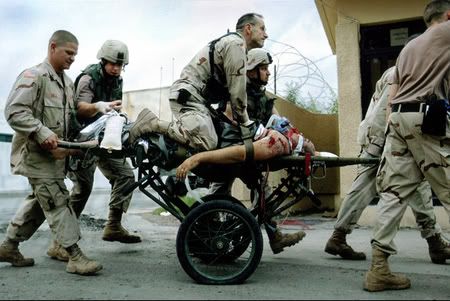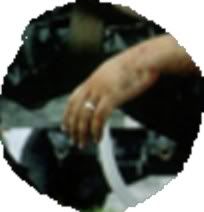Pulitzer Prize for AP Generates Controversy But....
Numerous on-line pundits such as Powerline, Captain's Quarters and Michelle Malkin have raised criticism over Associated Press' use of unprovinanced photos taken of Iraqi insurgents commiting murder, executions and attacks against Iraqi civilians and coalition troops. Several of these photos were part of the photo essays that brought a Pulitzer Prize for photo-journalism yesterday.
The moral and ethical implications involving how these photos were procured and the circumstances under which they were taken are serious and worrisome. Clearly, at least some of the photos (such as this one) were taken with the consent of the insurgents if not by the insurgents themselves. AP concedes that the photographer of this particular photo was "tipped off" that there would be a "demonstration" at that location and that, apparently, there would be some good photo ops.
Is this photo-journalism or is it collaboration with murderous thugs for purposes of promoting fear and terror among the Iraqis? Has AP sold its soul for a Pulitzer Prize in exchange for serving as a propoganda outlet for the killers of Americans (and many others) in Iraq?
The evidence, unfortunatly, suggests that the answer is "yes." How sad that these staged and premeditated media murders have been rewarded with such a prestigious prize. What if an AP photographer had been "tipped off" by Al Capone to the St. Valentine's Day Massacre back in 1929 Chicago? The photos would have been spectacular, of course. But would they have been phot-journalism? or just cheap shots?
Having said all this I do feel that the AP has captured some very moving images in Iraq. Unlike the execution photo referred to above (which is nothing more than a snapshot of a public murder ,revealing little and telling no real story), other photos are mini photo-essays even without accompanying texts. This is one of my favorites. But the most moving story of all is perhaps hidden in the small detail of this photo of Army Spc. Travis S. Babbit, 24, wounded in an attack in Baghdad on November 9, 2004.

The telling detail in this picture is right here:

Spc. Babbit, who was from Uvalde, Texas, later died of his wounds.
The moral and ethical implications involving how these photos were procured and the circumstances under which they were taken are serious and worrisome. Clearly, at least some of the photos (such as this one) were taken with the consent of the insurgents if not by the insurgents themselves. AP concedes that the photographer of this particular photo was "tipped off" that there would be a "demonstration" at that location and that, apparently, there would be some good photo ops.
Is this photo-journalism or is it collaboration with murderous thugs for purposes of promoting fear and terror among the Iraqis? Has AP sold its soul for a Pulitzer Prize in exchange for serving as a propoganda outlet for the killers of Americans (and many others) in Iraq?
The evidence, unfortunatly, suggests that the answer is "yes." How sad that these staged and premeditated media murders have been rewarded with such a prestigious prize. What if an AP photographer had been "tipped off" by Al Capone to the St. Valentine's Day Massacre back in 1929 Chicago? The photos would have been spectacular, of course. But would they have been phot-journalism? or just cheap shots?
Having said all this I do feel that the AP has captured some very moving images in Iraq. Unlike the execution photo referred to above (which is nothing more than a snapshot of a public murder ,revealing little and telling no real story), other photos are mini photo-essays even without accompanying texts. This is one of my favorites. But the most moving story of all is perhaps hidden in the small detail of this photo of Army Spc. Travis S. Babbit, 24, wounded in an attack in Baghdad on November 9, 2004.

The telling detail in this picture is right here:

Spc. Babbit, who was from Uvalde, Texas, later died of his wounds.


<< Home